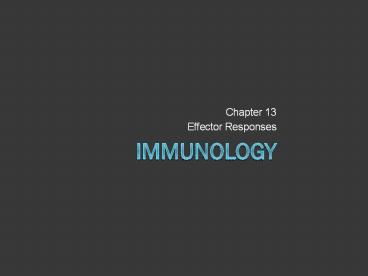Immunology - PowerPoint PPT Presentation
Title:
Immunology
Description:
Title: Kuby Immunology 6/e Author: Kindt, Goldsby, Osborne Last modified by: sb Created Date: 12/24/2002 1:08:46 AM Document presentation format: On-screen Show (4:3) – PowerPoint PPT presentation
Number of Views:157
Avg rating:3.0/5.0
Title: Immunology
1
Immunology
- Chapter 13
- Effector Responses
2
Antibody Mediated Effector Functions
- Neutralization
- Opsonization
- Complement fixation
- Antibody-dependent cell-mediated cytotoxicity
3
Antibody-dependent cell-mediated cytotoxicity
(ADCC)
- Cells that have cytotoxic potential express
receptors for Fc portion of antibody
4
Antibody Isotypes Mediate Different Effector
Functions
- IgM
- Fixes complement
- Very good at grabbing pathogens
- IgG
- Fixes complement
- Mediate ADCC
- IgA
- Neutralize toxins and pathogens
- In secretions
- IgE
- Inflammation, parasite
5
- Fc receptors
- Antibody binds antigen with Fab portion, Fc
portion is free to bind with Fc receptors on
immune cells for phagocytosis, etc.
6
Cell Mediated Immunity
- Important in detecting and eliminating cells that
harbor intracellular pathogens - Antigen specific
- CD8 and CD4 T cells
- Nonspecific cells
- NK cells, non-lymphoid types such as macrophages,
neutrophils, and eosinophils
7
Effector Responses
- Importance of these become evident when system is
defective - DiGeorge Syndrome
- Born without thymus, lack T cell component
- Can fight extracellular pathogens but have issues
with intracellular pathogens (viruses,
intracellular bacteria) - Effector T cells express variety of effector
molecules
8
Cytotoxic T cells
- CTLs or Tc cells, CD8
- Class I MHC restricted
9
Generation of effector CTLs from precursor CTLs
10
(No Transcript)
11
Effector phase of CTLs
- CTL-Mediated Death
- Conjugate formation of CTL with infected cell
- Membrane attack
- CTL dissociation
- Target cell destruction
Granules contain perforin
12
(No Transcript)
13
Natural Killer Cells (NK)
- Defend against viruses, other intracellular
pathogens, and tumors - Produce important cytokines
- Lymphoid cells
- Share early lineage to T cells
- NK cells dont develop exclusively in thymus
- Killing of target cell is similar to that of CTL
14
NK Cells
- Opposing signals model
- Many different receptors for activation and
different inhibitory ones - NK receptors
- Lectin-like
- Actually bind proteins instead of carbs
- Immunoglobulin-like
- Balance between activation and inhibitory signals
allows NK to distinguish between self and nonself - Very complicated
15
NK Cells
- Receiving both inhibitory and activating signals
- Only receiving activating signal
NK cells do not have capability of recognizing
MHC and antigen like T cell they recognize
altered cell surface molecules, possibly lowered
Class I MHC
16
NKT cells
- Cells that have characteristics common to CTLs
and NK cells - Considered part of the innate immune system
- Role remains to be completely defined
17
Experimental Assessment of CML
- Mixed Lymphocyte Reaction (MLR)
- T lymphocytes from 2 donors undergo extensive
proliferation when mixed - Each donors MHC is the antigen
- If MHC is same on both donors cells then there
is no reaction - If MHC is different, each donors T cells will
react to each other and will proliferate - Degree can be measured by adding 3H-Thymidine
to culture and monitoring uptake into DNA
18
(No Transcript)
19
Experimental Assessment of CML
- Cell-mediated lympholysis
- Target cells are labeled intracellularly with
51Cr (will not pass out of the cell unless cell
is lysed) - If there is cell-mediated cytotoxicity, then 51Cr
will be detected

